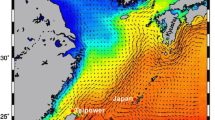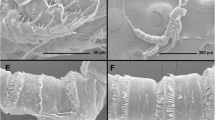Abstract
The genetic population structure of the precominant zooplankter, the copepod Calanus finmarchicus (Gunnerus), was examined to determine whether genetically distinct populations exist in the Gulf of Maine. C. finmarchicus was sampled in three regions of the Gulf of Maine (Great South Channel, spring 1989; northern Gulf of Maine, winter 1990; Great South Channel and Georges Bank, spring 1990). Copepods from seven locations in the Great South Channel, five in the northern Gulf of Maine and four on or near Georges Bank were assayed for allozyme variation and mitochondrial DNA variation of amplified 16S rRNA and cytochrome b genes. Restriction fragment length polymorphism (RFLP) analyses of both mitochondrial DNA genes revealed no variation among any of the individuals assayed. Analysis of five polymorphic allozyme loci revealed that genetic variation among the three geographic regions was low, and genetic identities were high between all locations (I>0.97). Most of the genetic variation was among locations regardless of region. Chi-square tests were used to examine genetic similarity between specific pairs of locations within and between regions. In the northern Gulf of Maine, genetic homogeneity occurred over larger spatial scales (hundreds of km) than in either the Great South Channel or Georges Bank (tens of km). Only copepods from the Bay of Fundy and Nova Scotian Shelf locations were genetically distinct from Wilkinson Basin copepods at two loci. Copepod populations from the northern locations may have been partially isolated or they may represent immigrant populations (e.g., from the Gulf of St. Lawrence). Several pairs of locations were genetically distinct at one or more loci in the two southern regions. Differences between locations in these regions may represent distinct populations advected into the areas at different times or from different sources (e.g., genetic variation may represent a mixture of genetically distinct northern and southern copepod populations). These results suggest extensive gene flow among populations of C. finmarchicus in the Gulf of Maine with some evidence of genetic population subdivision near the Gulf's northeastern and southern boundaries.
Similar content being viewed by others
References
Ayala F, Hedgecock D, Zumwalt G, Valentine J (1973) Genetic variation in Tridacna maxima, an ecological analog of some unsuccessful evolutionary lineages. Evolution 27:177–191
Ayala FJ, Valentine J, Zumwalt GS (1975) An electrophoretic study of the Antarctic zooplankter Euphausia superba. Limnol Oceanogr 20:635–639
Beardsley RC, Chen C, Wishner K, Macaulay M (1990) Spatial variability in stratification and zooplankton distributions near feading right whales in the Great South Channel. ESO, Madr 71 (Abst):68
Bigelow HB (1926) Plankton of the offshore waters of the Gulf of Maine. Bull US Bur Fish 40:1–509
Bigelow HB (1927) Physical oceanography of the offshore waters of the Gulf of Maine. Bull US Bur Fish 40:511–1027
Boileau M, Hebert P (1988) Genetic differentiation of freshwater copepods at Arctic sites. Hydrobiologia 167/168:393–400
Brooks DA (1992) A brief overview of the physical oceanography of the Gulf of Maine. In: Wiggin J, Mooers NK (eds) Proceedings of the Gulf of Maine Scientific Workshop. Urban Harbors Institute, University of Massachusetts, Boston, pp 51–74
Brown RG, Gaskin DE (1989) Summer zooplankton distributions at the surface of the outer Bay of Fundy, eastern Canada. Can J Zool 67:2725–2730
Brown W, George M, Wilson A (1979) Rapid evolution of animal mitochondrial DNA. Proc natn Acad Sci USA 76:1967–1971
Bucklin A (1989) Genetic tracers of zooplankton transport in coastal filaments off northern California. J geophys Res 94:8277–8288
Bucklin A, Frost BW, Kocher TD (1992) DNA sequence variation of the mitochondrial 16S rRNA in Calanus (Copepoda; Calanoida): intraspecific and interspecific patterns. Molec mar Biol Biotechnol 1:397–407
Bucklin A, Kann LM (1991) Mitochondrial DNA variation of copepods: markers of species identity and population differentiation of Calanus. Biol Bull mar biol Lab, Woods Hole 181:P357
Bucklin A, Marcus N (1985) Genetic differentiation of populations of the planktonic copepod Labidocera aestiva. Mar Biol 84:219–224
Burton RS, Feldman MW (1981) Population genetics of Tigriopus californicus. II. Differentiation among neighboring populations. Evolution 35:1192–1205
Burton RS, Feldman MW, Curtsinger JW (1979) Population genetics of Tigriopus californicus (Copepoda: Harpacticoida) I. Population structure along the Central California Coast. Mar Ecol Prog Ser 1:29–39
Butman B, Beardsley RC, Magnell B, Frye D, Vermersch JA, Schlitz R, Limeburner R, Wright WR, Noble MA (1982) Recent observations of the mean circulation on Georges Bank. J phys Oceanogr 12:569–591
Carr SM, Marshall HD (1991) Detection of intraspecific DNA sequence variation in the mitochondrial cytochrome b gene of Atlantic cod (Gadus morhua) by the polymerase chain reaction. Can J Fish aquat Sciences 48:48–52
Chen C (1992) Variability of currents in Great South Channel and over Georges Bank. Ph.D. thesis, Massachusetts Institute of Technology/Woods Hole Oceanography Institution Joint Program. Tech Rep Woods Hole Oceanogr Instn 92(20)
Chen C, Beardsley RC, Limeburner R (1995a) Variability of water properties in late spring in the northern Great South Channel. Contin Shelf Res 15:415–431
Chen C, Beardsley RC, Limeburner R (1995b) Variability of currents in late spring in the northern Great South Channel. Contin Shelf Res 15:451–473
Davis CS (1987) Zooplankton life cycles. In: Backus RH, Bourne DW (eds) Goerges Bank. MIT Press, Cambridge
Dillon RT, Manzi JJ (1992) Population genetics of the hard clam, Mercenaria mercenaria, at the northern limit of its range. Can J Fish aquat Sciences 49:2574–2578
Durbin EG, Campbell RG, Larimer SN, Durbin AG (1995) Diel feeding behaviour and ingestion rate in the copepod Calanus firmarchicus in the southern Gulf of Maine and Bay of Fundy during late spring. Contin Shelf Res 15:539–570
Fevolden SE, Ayala FJ (1981) Enzyme polymorphism in Antartic krill (Euphausia); genetic variation between populations and species. Sarsia 66:167–181
Fish CJ (1936) The biology of Calanus finmarchicus in the Gulf of Maine and Bay of Fundy. Biol Bull mar biol Lab, Woods Hole 70:118–141
Fleminger A, Hulsemann K (1977) Geographical range and taxonomic divergence in North Atlantic Calanus (C. helgolandicus, C. firmarchicus and C. glacialis). Mar Biol 40:233–248
GLOBEC (1991) GLOBEC: Northwest Atlantic Program No. 2. Bedford Institute of Oceanography, Dartmouth, Nova Scotia
Graham JJ (1970) Coastal currents of the western Gulf of Maine. Res Bull int Commn NW Atlant Fish 7:19–31
Hall G, Smith D (1991) Distinguishing African and European honeybee matrilines using amplified mtDNA. Proc natn Acad Sci USA 88:4548–4552
Hebert P, Beaton M (1989) Methodologies for allozyme analysis using cellulose acetate electrophoresis. Educational Service of Helena Laboratories, Beaumont, Texas
Herman AW, Sameoto D, Shunnian C, Mitchell M, Petrie B, Cochrane N (1991) Sources of zooplankton on the Nova Scotia Shelf and their aggregations within deep-shelf basins. Contin Shelf Res 11:221–238
Jossi JW, Goulet JR (1990) Zooplankton community abundance, coherence, and stability of the Northeast Shelf Ecosystem. Int Counc Explor Sea Comm Meet, (Oceanogr biol Comm) L93
Kann LM, Wishner K (1995) Spatial and temporal patterns of zooplankton populations in the Great South Channel during spring. J Plankton Res 17(2):235–262
Koehn R, Hall J, Innes D, Zera A (1984) Genetic differentiation of Mytilus edulis in eastern North America. Mar Biol 79:117–126
Levene H (1949) On a matching problem arising in genetics. Ann math Statist 20:91–94
Limeburner R, Beardsley R (1989) CTD observations in the Great South Channel during the South Channel Ocean Productivity Experiment SCOPEX, May-June 1989. Tech Rep Woods Hole Oceanogr Instn 89(51)
Marshall S, Orr AP (1995) The biology of a marine copepod, Calanus finmarchicus Gunnerus. Oliver and Boyd, Edinburgh
McLean M, Okubo C, Tracey M (1983) Mitochondrial DNA heterogeneity in planulirus argus. Experientia 39:536–537
McLaren IA, Tremblay MJ, Corkett CJ, Roff JC (1989) Copepod production on the Scotian Shelf based on life-history analyses and laboratory rearings. Can J Fish aquat Sciences 46:560–583
Meise-Munns C, Green J, Ingham M, Mountain D (1990) Interannual variability in the copepod populations of Georges Bank and the western Gulf of Maine. Mar Ecol Prog Ser 65:225–232
Nei M (1978) Estimation of average heterozygosity and genetic distance from a small number of individuals. Genetics NY 89:583–590
Palumbi SR, Benzie J (1991) Large mitochondrial differences between morphologically similar penaeid shrimp. Molec mar Biol Biotechnol 1:27–34
Palumbi SR, Martin A, Romano S, McMillan WO, Stice L, Grabowski G (1991) The simple fool's guide to PCR (unpublished manuscript)
Perry RI, Harding GC, Loder JW, Tremblay MJ, Sinclair M, Drinkwater KF (1993) Zooplankton distributions at the Georges Bank frontal system: retention or dispersion? Contin Shelf Res 13:357–383
Sameoto DD, Herman AW (1990) Life cycle and distribution of Calanus finmarchicus in deep basins on the Nova Scotia shelf and seasonal changes in Calanus spp. Mar Ecol Prog Ser 66:225–237
Sherman K, Green JR, Goulet J, Ejsymont L (1983) Coherence in zooplankton of a large northwest Atlantic ecosystem. Fish Bull US 81:855–862
Sherman K, Smith WG, Green JR, Cohen EB, Berman MS, Marti KA, Goulet JR (1987) Zooplankton production and the fisheries of the northeastern shelf. In: Backus RH, Bourne DW (eds) Georges Bank. Massachusetts Institute of Technology Press, Cambridge
Sokal RR, Rohlf FJ (1969) Biometry. W.H. Freeman and Company, San Francisco
Swofford DL, Selander RB (1989) BIOSYS-1: a computer program for the analysis of allelic variation in population genetics and biochemical systematics, Release 1.7. Illinois Natural History Survey, Champaign, Illinois
Tracey M, Nelson K, Hedgecock D, Shleser R, Pressick ML (1975) Biochemical genetics of lobsters: genetic variation and the structure of American lobster (Homarus americanus) populations. J Fish Res Bd Can 32(11):2091–2101
Wiebe PH, Burt KH, Boyd SH, Morton AW (1976) A multiple opening/closing net and environmental sensing system for sampling zooplankton. J mar Res 34:313–325
Wishner K, Durbin E, Durbin A, Macaulay M, Winn H, Kenney R (1988) Copepod patches and right whales in the Great South Channel off New England. Bull mar Sci 43:825–844
Wishner K, Schoenherr JR, Beardsley R, Chen C (1995) Abundance, distribution, and population structure of the copepod Calanus finmarchicus in a springtime right whale feeding area in the southwestern Gulf of Maine. Contin Shelf Res 15:475–507
Wishner K, Schoenherr JR, Gelfman C (1990) Variability of copepod distributions and vertical migration patterns in a right whale feeding area off Cape Cod. EOS, Madr 71 (Abst):68
Workman PL, Niswander JD (1970) Population studies on southwestern Indian tribes. II. Local genetic differentiation in the Papago. Am J hum Genet 22:24–29
Wright S (1965) The interpretation of population structure by F-statistics with special regard to systems of mating. Evolution 19:395–420
Wright S (1978) Evolution and genetics of populations. University of Chicago Press, Chicago
Author information
Authors and Affiliations
Additional information
Communicated by J.P. Grassle, New Brunswick
Rights and permissions
About this article
Cite this article
Kann, L.M., Wishner, K. Genetic population structure of the copepod Calanus finmarchicus in the Gulf of Maine: allozyme and amplified mitochondrial DNA variation. Marine Biology 125, 65–75 (1996). https://doi.org/10.1007/BF00350761
Received:
Accepted:
Issue Date:
DOI: https://doi.org/10.1007/BF00350761




